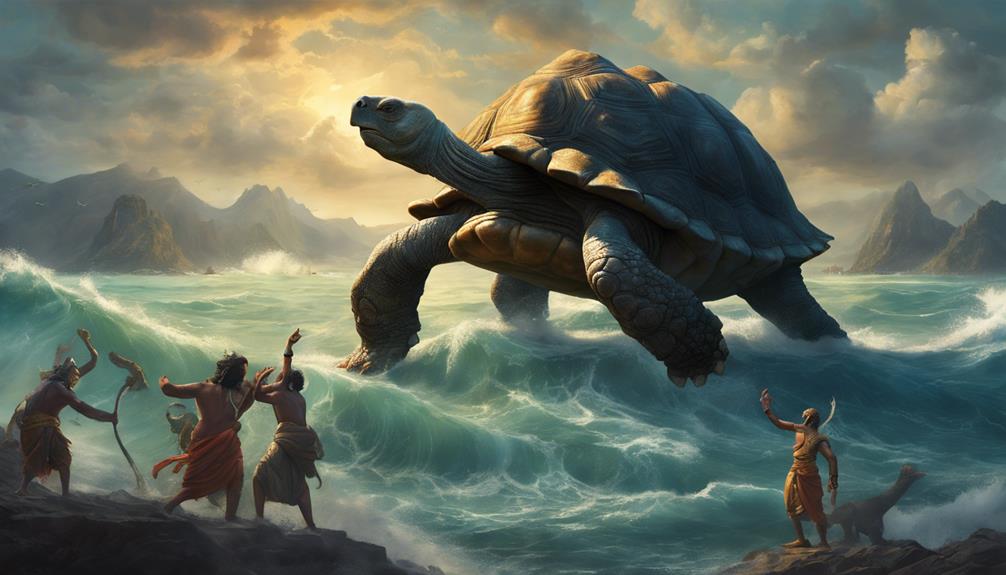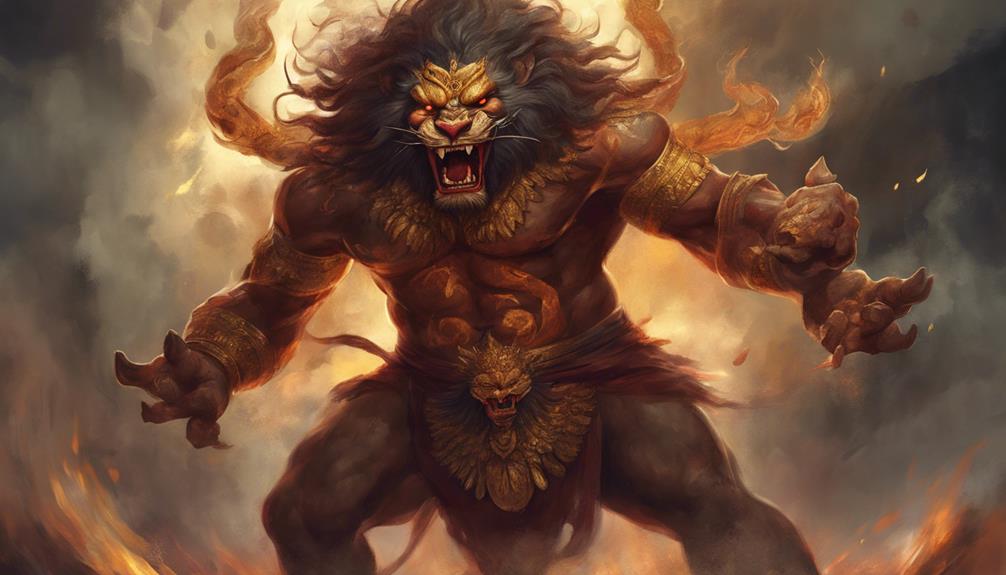Vishnu's avatars are significant embodiments of cosmic balance in Hindu mythology, each portraying specific moral and metaphysical messages. The Fish Incarnation, Matsya Avatar, symbolizes protection and the commencement of cosmic narratives, while the Tortoise Form, Kurma Avatar, teaches patience and perseverance through the churning of the cosmic ocean. Varaha Avatar, the Boar Manifestation, represents the eternal struggle between good and evil, emphasizing sacrifice and righteousness. The Lion-Human Hybrid, Narasimha Avatar, showcases the triumph of good over evil and divine justice prevailing, while the Dwarf Figure, Vamana Avatar, embodies omnipotence despite a small appearance.
Rama and Krishna, as human incarnations, exemplify righteousness, duty, divine playfulness, and love, hinting at deeper meanings within these divine narratives.
Table of Contents
Key Takeaways
- Avatars like Matsya, Kurma, and Varaha symbolize cosmic balance and preservation.
- Narasimha represents divine protection and justice prevailing over evil.
- Vamana embodies omnipresence and immense power in a humble form.
- Rama and Krishna are human incarnations exemplifying righteousness and divine playfulness.
- Each avatar teaches moral lessons and upholds cosmic harmony in Hindu mythology.
Origins of Vishnus Avatars
The origins of Vishnu's avatars can be traced back to ancient Hindu scriptures and myths that depict the divine incarnations as manifestations of cosmic balance and preservation. These avatars aren't merely characters in tales but hold deep mythological origins and significance. In the historical context of ancient India, the concept of avatars served a dual purpose of entertaining and educating the masses while also symbolizing profound philosophical ideas.
Vishnu's avatars aren't arbitrary; each one has a specific purpose and symbolism attached to it. They're believed to appear in times of crisis to restore cosmic order and protect dharma. The avatars symbolize the eternal battle between good and evil, with Vishnu embodying the ultimate good that triumphs over malevolence.
The stories of Vishnu's avatars provide moral lessons and convey complex metaphysical concepts in an accessible manner. Through these divine manifestations, individuals are encouraged to reflect on the nature of existence, the consequences of actions, and the ultimate goal of spiritual liberation.
Matsya Avatar: The Fish Incarnation
Emerging from the depths of ancient Hindu mythology, the Matsya Avatar signifies the beginning of a profound cosmic narrative. This first incarnation of Vishnu takes the form of a fish, embodying aquatic symbolism and divine protection.
The story of Matsya Avatar revolves around a great flood that threatens to submerge the world. Vishnu appears as a fish to guide the righteous king Manu, saving him from the deluge by towing his boat to safety. The oceanic origins of Matsya Avatar highlight its connection to primal waters and the concept of cosmic balance.
Matsya Avatar serves as a symbol of protection and preservation, showcasing Vishnu's role as the preserver in the Hindu trinity. Through this incarnation, Vishnu demonstrates his commitment to safeguarding the universe and its inhabitants from destruction. The aquatic imagery associated with Matsya Avatar underscores the idea of life emerging from the primordial waters, echoing themes of creation and renewal.
Essentially, Matsya Avatar sets the stage for the unfolding drama of Vishnu's subsequent incarnations, each playing an important role in maintaining cosmic order and harmony.
Kurma Avatar: The Tortoise Form

The Kurma Avatar, symbolized by a tortoise form, holds profound significance in Hindu mythology. This incarnation is often associated with the representation of a protective shell, symbolizing security and stability.
Additionally, the Kurma Avatar plays an essential role in the churning of the cosmic ocean, a mythological event that reveals deeper insights into the cycle of creation and preservation in Hindu belief.
Symbolic Shell Representation
Within the symbolic representation of the Kurma Avatar, Vishnu manifests in the form of a tortoise, symbolizing profound layers of meaning and significance. The shell of the tortoise embodies protection and stability, reflecting Vishnu's role as the preserver and protector in Hindu cosmology.
The shell's shape represents the universe, with its dome symbolizing the heavens and the lower part indicating the earthly domains. This imagery conveys the idea of Vishnu upholding and encompassing the entire cosmos within himself.
The tortoise's ability to retract its limbs signifies the power of withdrawal and introspection, highlighting the importance of inner reflection and contemplation in spiritual growth. Overall, the Kurma Avatar's symbolic shell representation serves as a visual metaphor for divine protection, cosmic unity, and introspective wisdom.
Churning Ocean Mythology
In exploring the mythology of the Churning Ocean associated with the Kurma Avatar in its tortoise form, one uncovers profound symbolism and cosmic significance deeply rooted in Hindu cosmology.
The ocean symbolism in this myth represents the vast expanse of consciousness from which all creation emerges. The act of churning symbolizes the spiritual journey of self-discovery and transformation, where inner virtues are brought to the surface.
In this creation story, the divine manifestations of gods and demons working together depict the harmony and balance needed to achieve great tasks. The Kurma Avatar's role as the tortoise signifies stability, patience, and support in the face of challenges.
This symbolic narrative teaches valuable lessons about perseverance, cooperation, and the eternal cycle of creation and destruction.
Varaha Avatar: The Boar Manifestation
Looming large in Hindu mythology, Varaha Avatar emerges as a formidable and intriguing manifestation of Lord Vishnu. This incarnation is depicted as a boar, symbolizing strength, protection, and the ability to unearth hidden truths. Varaha Avatar holds mythological significance in various texts, most strikingly in the tale of lifting the Earth Goddess, Bhudevi, from the depths of the cosmic ocean. The boar's tusks represent the dual nature of creation and destruction, showcasing Vishnu's role in maintaining cosmic order.
Varaha Avatar's mythological narrative underscores the eternal struggle between good and evil, as Vishnu battles the demon Hiranyaksha to restore balance and protect the universe. The boar's form also symbolizes humility, as Vishnu takes on an animal incarnation to fulfill a divine mission selflessly. Through Varaha Avatar, devotees learn about sacrifice, courage, and the importance of upholding righteousness in the face of adversity. This manifestation serves as a reminder of Vishnu's omnipotence and unwavering commitment to preserving cosmic harmony.
Narasimha Avatar: The Lion-Human Hybrid

Have you ever wondered about the significance behind the intriguing manifestation of Lord Vishnu known as Narasimha Avatar, the Lion-Human Hybrid? Narasimha Avatar is a powerful incarnation where Lord Vishnu takes the form of a half-lion and half-man figure to protect his devotees and uphold righteousness.
This avatar is associated with the concept of divine protection, symbolizing the idea that the divine is always present to safeguard the virtuous and eliminate evil forces. The image of Narasimha tearing apart the demon Hiranyakashipu, who couldn't be guaranteed by man or beast, represents the triumph of good over evil and the assurance that the divine will intervene to make certain justice prevails.
Moreover, Narasimha Avatar also signifies spiritual transformation. The fierce and awe-inspiring form of the lion-human hybrid serves as a reminder that sometimes spiritual growth requires confronting our inner demons with courage and determination. By embracing the challenges posed by our own fears and shortcomings, we can undergo a profound metamorphosis towards enlightenment and self-realization.
Vamana Avatar: The Dwarf Figure
With a subtle yet profound presence, the Vamana Avatar of Lord Vishnu emerges as a significant embodiment in Hindu mythology, embodying the form of a dwarf figure. This avatar holds a deep symbolic representation and cosmic significance within the Hindu pantheon. Vamana is often depicted as a dwarf Brahmin who approached the demon king Bali to request three paces of land. However, in a cosmic twist, Vamana expanded in size, covering the entire universe in two steps, thereby symbolizing the omnipresence and omnipotence of Vishnu.
The dwarf figure of Vamana represents humility and the idea that the divine can manifest in unexpected forms. Despite his small appearance, Vamana's actions demonstrate immense power and control over the universe. This avatar showcases the concept that size and stature don't limit one's significance or impact. Vamana's cosmic significance lies in his ability to restore balance and order in the universe, emphasizing the idea that divinity transcends physical attributes and can manifest in ways that challenge conventional expectations.
Rama and Krishna: Human Incarnations
Rama and Krishna, revered as human incarnations of Lord Vishnu in Hindu mythology, embody profound symbolism and significance within the religious narrative. Rama, from the epic Ramayana, was born in the Ikshvaku dynasty, tracing his lineage to King Raghu. His life exemplifies righteousness, duty, and honor, portraying the ideal prince and king. Rama's unwavering devotion to dharma and his adherence to truth even in adversity make him a revered figure in Hinduism, with his story serving as a moral compass for devotees.
Krishna, on the other hand, known for his mischievous yet endearing childhood antics, was a cowherd in Vrindavan before becoming a key figure in the Mahabharata. His childhood tales, such as the playful stealing of butter (Makhan Chor) and his enchanting flute melodies, captivate devotees and symbolize the divine playfulness and love that he embodies. Krishna's teachings in the Bhagavad Gita emphasize the importance of fulfilling one's duties without attachment to the outcomes, guiding followers on the path of righteousness and devotion.
Frequently Asked Questions
How Do the Avatars of Vishnu Relate to Other Deities in Hindu Mythology?
When exploring the Avatars of Vishnu in Hindu mythology, you'll find intricate relationships with other deities. Their significance lies in how they connect and compare mythologically, showcasing diverse roles and divine qualities within the pantheon.
Are There Any Specific Rituals or Practices Associated With Worshipping Vishnu's Avatars?
When worshiping Vishnu's avatars, devotees often engage in specific rituals and practices. These may include reciting prayers, performing aartis, offering flowers, incense, and food. Each ritual holds symbolic significance, highlighting the divine nature of the avatars.
What Are Some Lesser-Known Stories or Legends About Vishnu's Avatars?
Explore the symbolic representations and folklore tales, investigating the lesser-known stories of Vishnu's avatars. Uncover cultural interpretations and mythological significance within these narratives, shedding light on the diverse and intriguing aspects of these divine manifestations.
How Do the Avatars of Vishnu Play a Role in Modern Hindu Practices and Beliefs?
In modern Hindu practices and beliefs, the avatars of Vishnu hold immense significance. Their contemporary worship reflects a deep connection to ancient traditions, offering devotees guidance and inspiration in maneuvering life's challenges with faith and devotion.
Are There Any Temples or Sacred Sites Dedicated Specifically to Vishnu's Avatars?
You can find temples dedicated to Vishnu's avatars in various regions, each highlighting the symbolism and significance of these divine incarnations. These sacred sites serve as focal points for worship, reflection, and spiritual connection.
Conclusion
To sum up, the incarnations of Vishnu play a vital role in Hindu mythology and are believed to uphold righteousness and restore balance in the universe. Each avatar represents a different facet of Vishnu's power and divine purpose, offering guidance and protection to devotees.
Through their various forms and deeds, the avatars serve as a source of inspiration and spiritual guidance for believers, emphasizing the significance of faith, devotion, and the eternal cycle of creation and destruction.